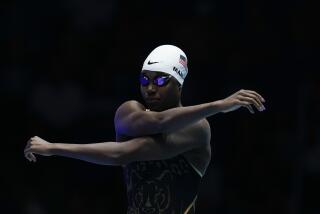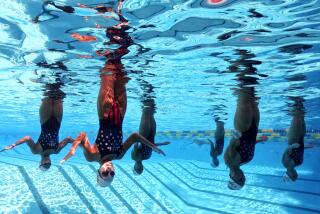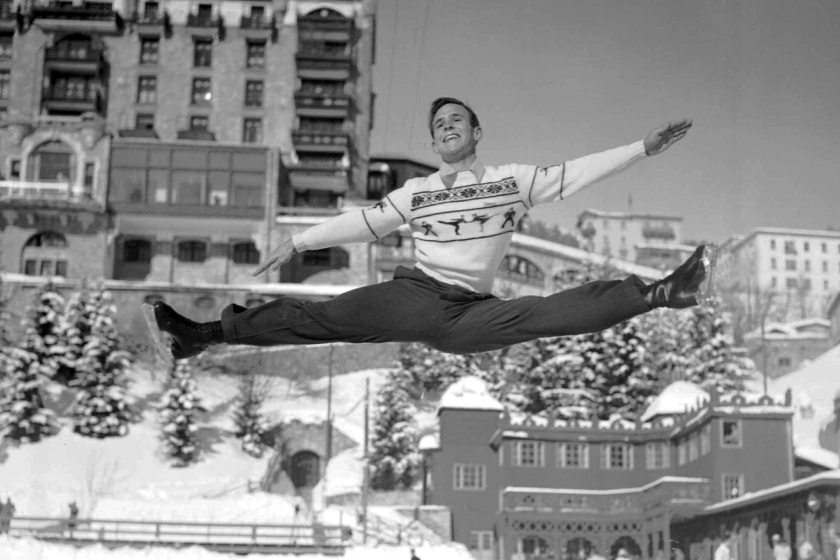Olympic Swimmer Sandeno Spreads Word About Asthma
- Share via
ATLANTA — Kaitlin Sandeno likes to stay busy. She swam in four grueling events at the Athens Olympics, winning three medals and just missing a fourth.
Now, with a little down time on her hands before 2008, Sandeno is taking on a new challenge, traveling the country to tell Americans it’s possible to control the debilitating effects of asthma.
Just as she has for the past 2 1/2 years.
“It’s something I’m really passionate about,” Sandeno said during a stop in Atlanta. “I’m letting people know there’s controlled asthma and non-controlled asthma. You don’t have to live with coughing and wheezing and using an inhaler.”
Sandeno lived that way for years. She was diagnosed with the breathing disorder at age 12, but it wasn’t until 2 1/2 years ago that she was given a medication that could curtail her symptoms.
Now, she’s able to breathe more comfortably, without the constant gasping for air. That’s the message she wants to spread to the estimated 20 million asthmatics in the United States.
“I always did a lot of coughing. It was hard to catch my breath. I would feel like I was breathing out of a coffee stirrer,” Sandeno said. “It’s scary when you’re having asthma attacks. I train five hours a day, swimming 8,000 meters in practice. Sometimes, I would have to get out of the pool because I couldn’t catch my breath.”
Even while struggling for her next breath, the 22-year-old Californian managed to develop into one of the world’s most versatile swimmers.
Sandeno made the Olympic team in 2000, winning a bronze at Sydney in the 800-meter freestyle -- the longest race on the women’s program. Last summer, she was the female version of Michael Phelps, diving into the pool virtually every day in Athens.
The result: a gold on the world record-setting 800 free relay team, a silver in the 400 individual medley and a bronze in the 400 free. She missed a fourth medal by only 14-hundredths of a second, finishing fourth in the 200 butterfly.
“She’s a very interesting story,” said Dr. Kathy Sheerin, who specializes in breathing problems at the Atlanta Allergy and Asthma Clinic. “She was diagnosed with asthma at 12, but it was not treated properly. Who knows how many medals she might have won if they had put her on the right medicine?”
The breakthrough came while Sandeno was being treated for a stress fracture in her back after the Sydney Games.
Doctors took another look at her breathing disorder, switching her from a “rescue medication” -- which helped her cope when she was having trouble breathing -- to a “controller” that prevents the lungs from becoming inflamed in most cases.
Sandeno noticed a big difference right away.
“Now that it’s under control, I can go to practice and crank out the yardage, go to a meet and give 110 percent, and not have to worry about catching my breath,” she said.
Sandeno stresses that she’s not pushing her twice-a-day medication as a cure-all for asthma symptoms. Instead, she wants everyone who has trouble breathing to take a simple test that can help determine the proper course of treatment.
She’s spreading the word during a national tour with two other high-profile asthmatics: Pittsburgh Steeler running back Jerome Bettis and retired women’s basketball star Jennifer Azzi.
“People don’t have to live with these symptoms,” Sandeno said. “Sometimes, I don’t even realize I have asthma. I’m healthy, my asthma is under control and I can do all the activities I want. But you don’t have to be a high-level athlete to want to have your asthma under control.”
Studies have shown that athletes who play an outdoor sport appear to be at higher risk, Sheerin said. Swimmers seem especially susceptible to asthma, perhaps because of the effect chlorine has on their lungs.
Clearly, though, not just athletes are at risk. If anything, the breathing ailment might be contributing to the rising number of obese youngsters in this country.
More to Read
Go beyond the scoreboard
Get the latest on L.A.'s teams in the daily Sports Report newsletter.
You may occasionally receive promotional content from the Los Angeles Times.






